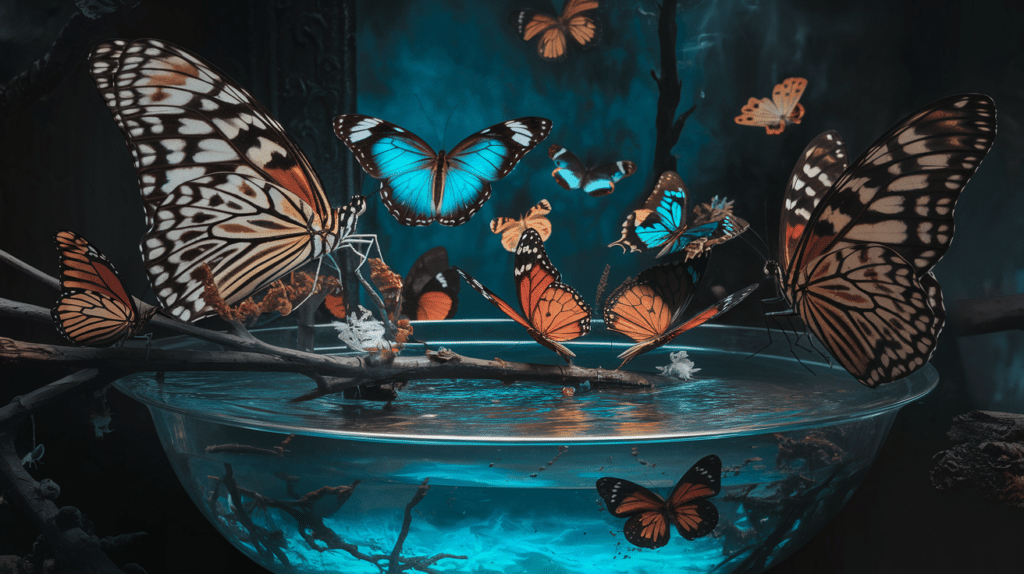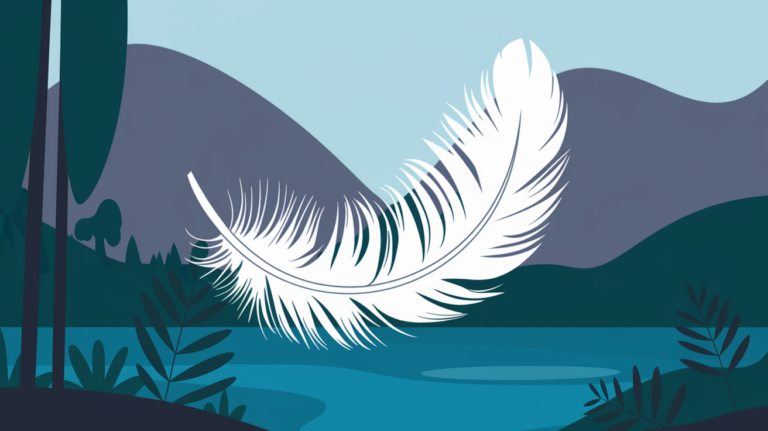Butterflies attract people with their vibrant colors and delicate wings.
These insects transform through one of nature’s most remarkable processes, yet many don’t understand their crucial role in our ecosystem.
Butterflies are essential pollinators and indicators of environmental health, but their populations face serious threats worldwide.
This article seeks the interesting world of butterflies as nature’s colorful messengers.
Readers will learn about their life cycle stages, from caterpillar to chrysalis to adult. The piece will examine how different butterfly species use their distinctive patterns for survival and communication.
It will also highlight conservation efforts anyone can support to protect these beautiful creatures.
By the end, readers will appreciate butterflies not just for their beauty, but for their vital importance to our natural world.
The Symbolism of Beautiful Butterflies in Culture
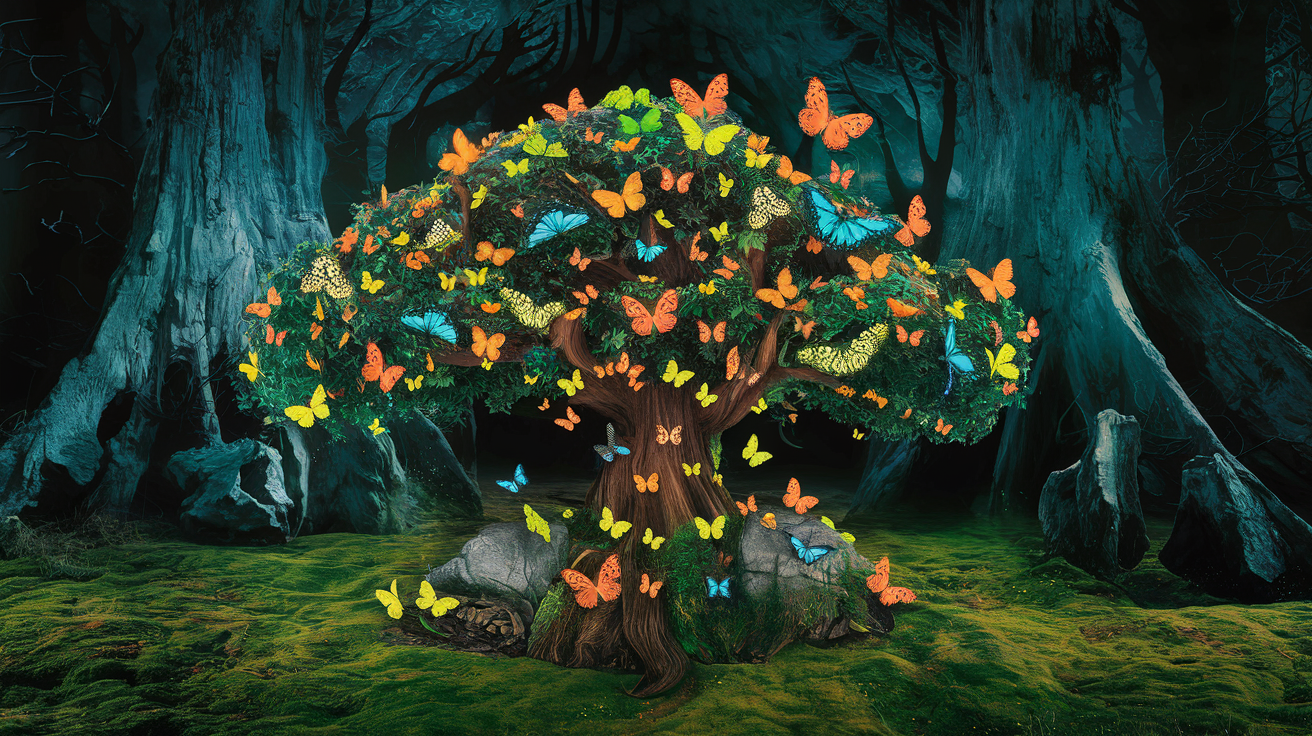
Butterflies hold powerful symbolic meaning across global cultures. Many cultures connect butterflies with rebirth.
- In Japan, they represent the souls of living and departed.
- Ancient Greeks saw them as symbols of the soul too. Their transformation mirrors personal growth.
- Christians view them as resurrection symbols.
- In Mexico, they’re linked to returning spirits during Day of the Dead celebrations.
- Chinese traditions associate them with joy and marital harmony.
- Native American tribes see butterflies as messengers carrying wishes to the Great Spirit.
- In some African cultures, they predict good fortune when entering homes.
Modern society still believe in butterfly symbolism. People get butterfly tattoos to mark personal transformation.
Artists feature them in works about change and beauty. Fashion designers use their patterns for inspiration.
Butterflies continue to bewitch us. Their brief yet colorful lives remind us of our own mortality. Their beauty transcends cultural boundaries.
How to Differentiate Between Moth and Butterfly
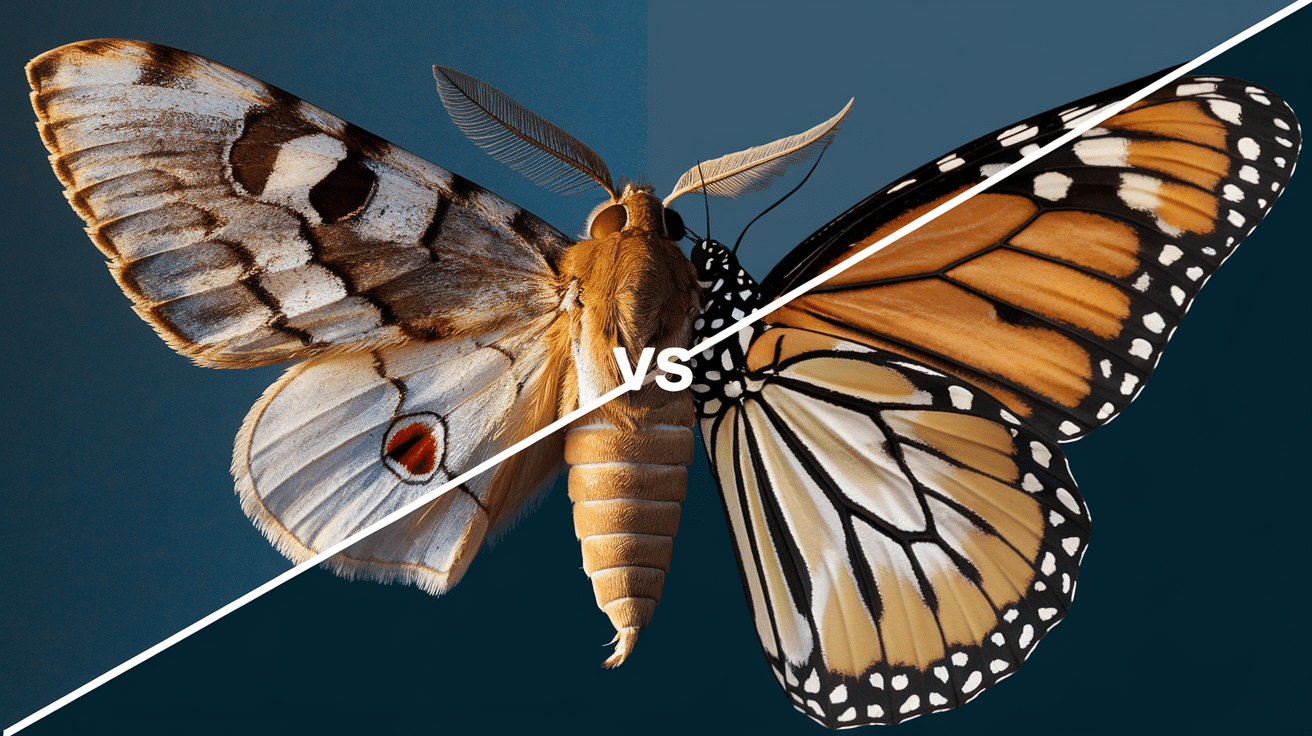
Many people mistake moths for butterflies and vice versa. It’s a common error.
The confusion makes sense since both belong to the order Lepidoptera. But several key differences help distinguish these winged insects from one another.
Learning these distinctions enhances your appreciation of these remarkable creatures.
| Feature | Butterflies | Moths |
|---|---|---|
| Antennae | Thin, club-shaped ends | Feathery or thread-like |
| Body Shape | Slender, smooth | Furry, stout |
| Wing Position at Rest | Wings held upright or closed | Wings spread flat or tent-like |
| Activity | Mostly diurnal (active during the day) | Mostly nocturnal (active at night) |
| Coloration | Bright and vibrant colors | Dull, earthy tones for camouflage |
| Pupal Stage | Forms a chrysalis (smooth, hard) | Forms a cocoon (silken covering) |
| Flight Pattern | Fluttering, graceful | Rapid, darting |
| Attraction to Light | Not strongly attracted to artificial lights | Strongly attracted to artificial lights (phototaxis) |
| Resting Position | Perches with wings folded vertically | Perches with wings spread open or flat |
| Leg Visibility | Front legs visible while resting | Often hides front legs under the body |
35 Most Beautiful Butterfly to Exist
1. Apollo Butterfly
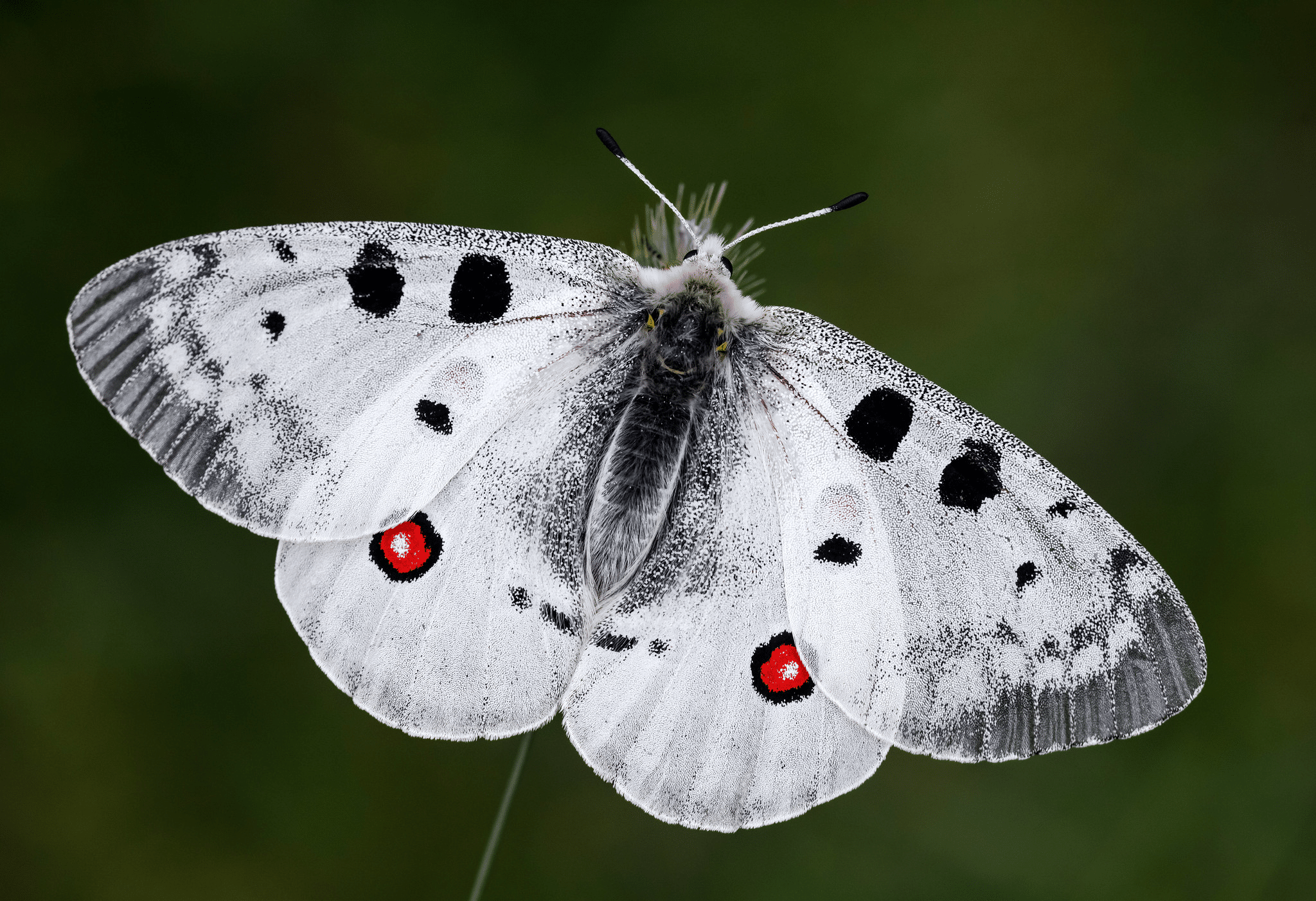
A true gem of the high-altitude meadows, the Apollo Butterfly is known for its magnificient white wings adorned with striking red and black eye spots.
It thrives in the cold mountain regions of Europe and Asia, gracefully fluttering among wildflowers.
Its presence is often an indicator of a healthy, unspoiled environment.
- Scientific Name: Parnassius apollo
- Family: Papilionidae
- Habitat: Alpine meadows, rocky slopes
- Physical Features: Large wings, semi-translucent white with black and red spots
- Colours in the Species: White, black, red
2. Black Swallowtail
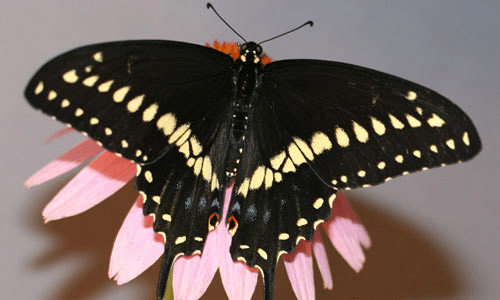
This butterfly dazzles with its deep black wings accented by blue and yellow markings.
A fast and erratic flyer, it’s commonly found fluttering through gardens and open fields in North America.
The females tend to have more pronounced blue coloring on their hindwings.
- Scientific Name: Papilio polyxenes
- Family: Papilionidae
- Habitat: Gardens, open meadows, and roadsides
- Physical Features: Medium-sized, long tails on hindwings
- Colours in the Species: Black, blue, yellow, orange
3. Blue Clipper
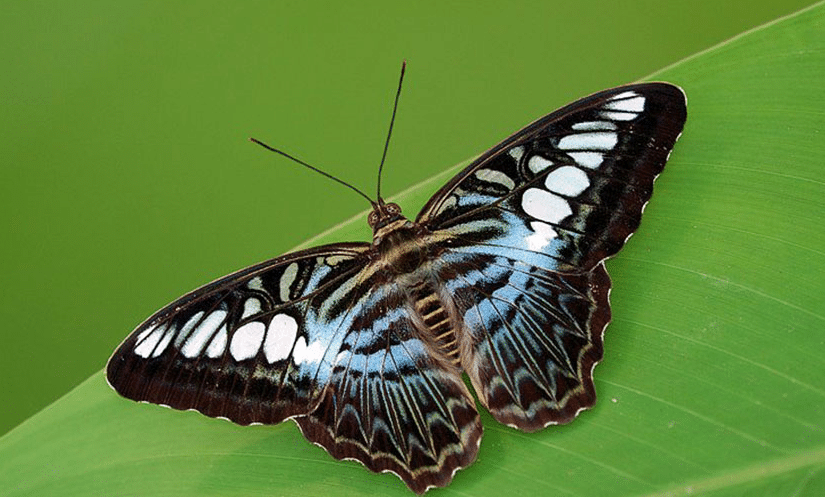
An agile flier, the Blue Clipper is a striking butterfly found in Southeast Asian forests.
It has mesmerizing metallic blue patterns on its wings, which contrast beautifully with the dark brown outlines.
These butterflies are known for their rapid and erratic flight patterns.
- Scientific Name: Parthenos sylvia lilacinus
- Family: Nymphalidae
- Habitat: Tropical rainforests, coastal areas
- Physical Features: Broad wings with blue iridescence and dark patterns
- Colours in the Species: Blue, brown, black, white
4. Blue Morpho
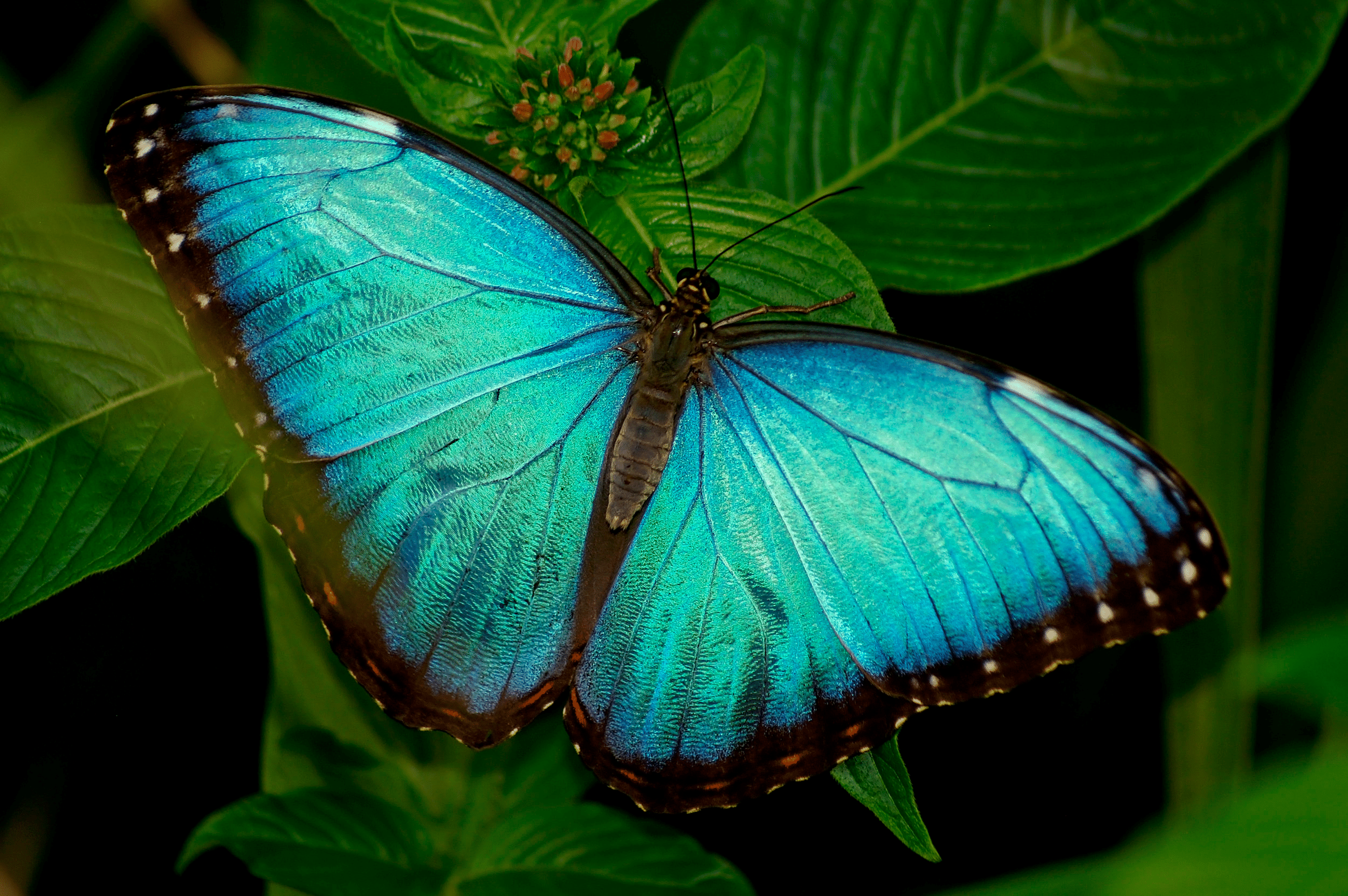
One of the most famous butterflies, the Blue Morpho is admired for its brilliant iridescent blue wings that shimmer in the light.
Native to the rainforests of South America, it spends most of its life hidden in the canopy, only revealing its dazzling color in flight.
- Scientific Name: Morpho menelaus
- Family: Nymphalidae
- Habitat: Rainforests, tropical woodlands
- Physical Features: Large wings, metallic blue coloration
- Colours in the Species: Iridescent blue, brown (underside)
5. Blue Tiger
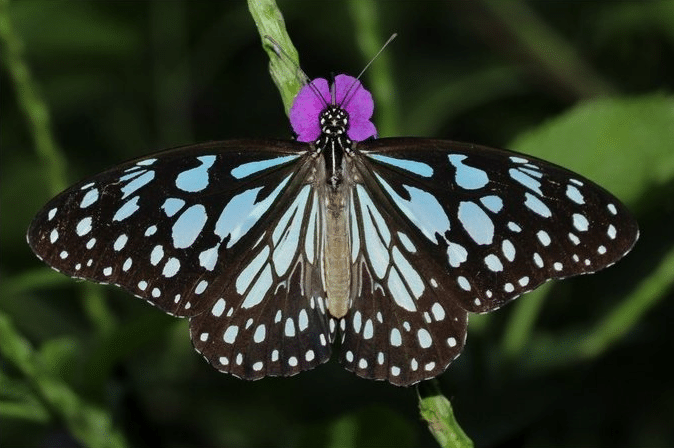
Graceful and delicate, the Blue Tiger butterfly glides effortlessly in search of nectar-rich flowers.
Its wings display a mesmerizing blend of black with sky-blue streaks, creating a striking contrast.
This butterfly is common in South and Southeast Asia.
- Scientific Name: Tirumala limniace
- Family: Nymphalidae
- Habitat: Tropical forests, grasslands, coastal areas
- Physical Features: Slender body, elongated forewings
- Colours in the Species: Black, blue, white
6. Chinese Moon Moth
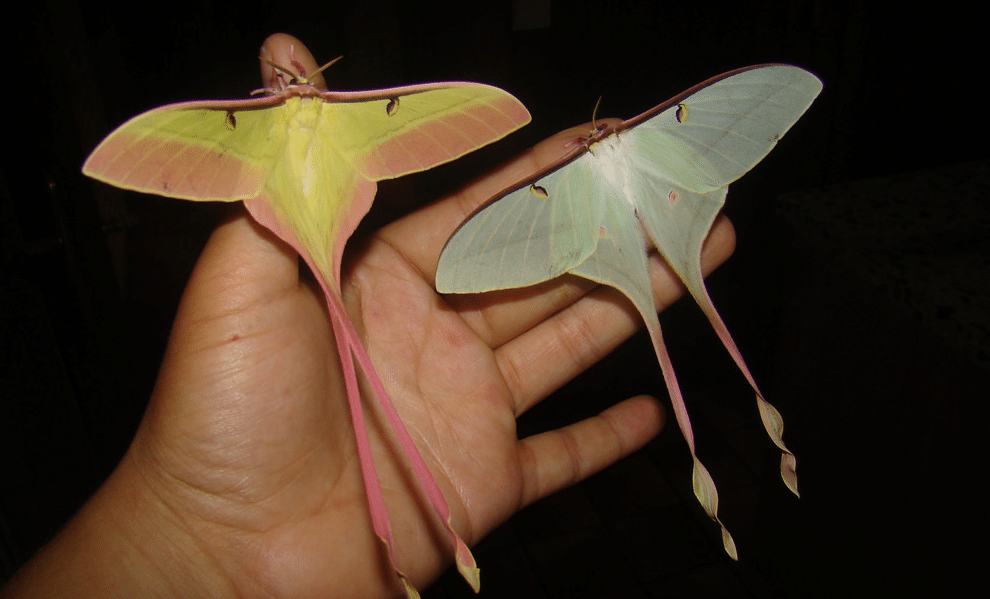
A spectacular moth with a dreamlike appearance, the Chinese Moon Moth has long tails on its hindwings and a soft green coloration.
Found in China and surrounding regions, it has a short adult lifespan, living only a few days to reproduce.
- Scientific Name: Actias dubernardi
- Family: Saturniidae
- Habitat: Temperate forests, mountainous regions
- Physical Features: Large wings, long hindwing tails
- Colours in the Species: Pale green, pink, yellow
7. Clipper
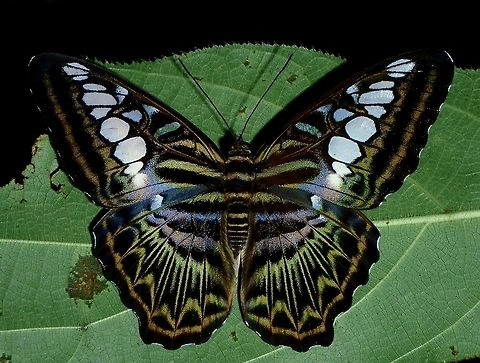
A rapid flier, the Clipper butterfly is recognized by its bold patterns and swift movements.
It is native to Southeast Asia and frequently seen in gardens and forests. The wings feature a stunning mix of brown, black, and blue hues.
- Scientific Name: Parthenos sylvia
- Family: Nymphalidae
- Habitat: Tropical forests, gardens
- Physical Features: Broad wings, contrasting patterns
- Colours in the Species: Blue, brown, black, white
8. Common Jezebel
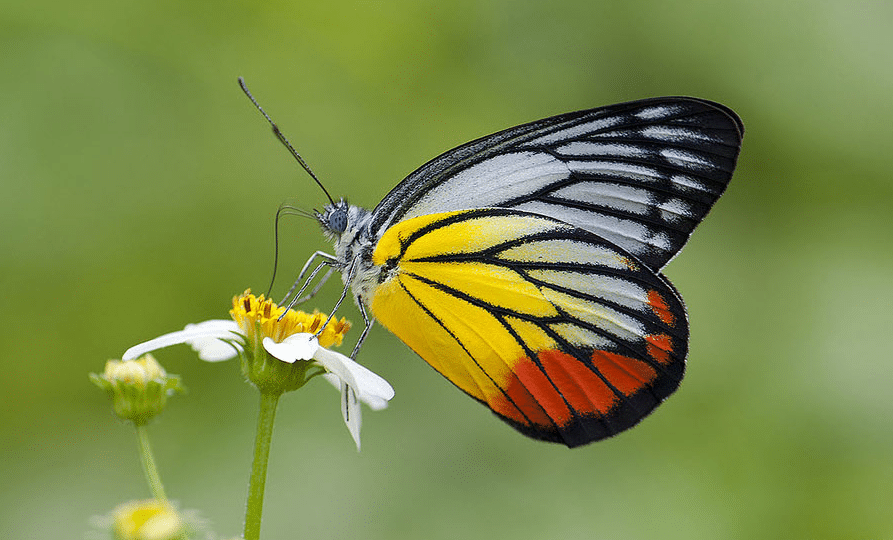
A butterfly that stands out due to its striking red, yellow, and black markings, the Common Jezebel is often seen flitting near flowering trees. It plays an important role in pollination and prefers higher elevations in South Asia and Australia.
- Scientific Name: Delias eucharis
- Family: Pieridae
- Habitat: Woodlands, gardens, urban areas
- Physical Features: Slender body, rounded wings
- Colours in the Species: Yellow, red, black, white
9. Dead Leaf Butterfly
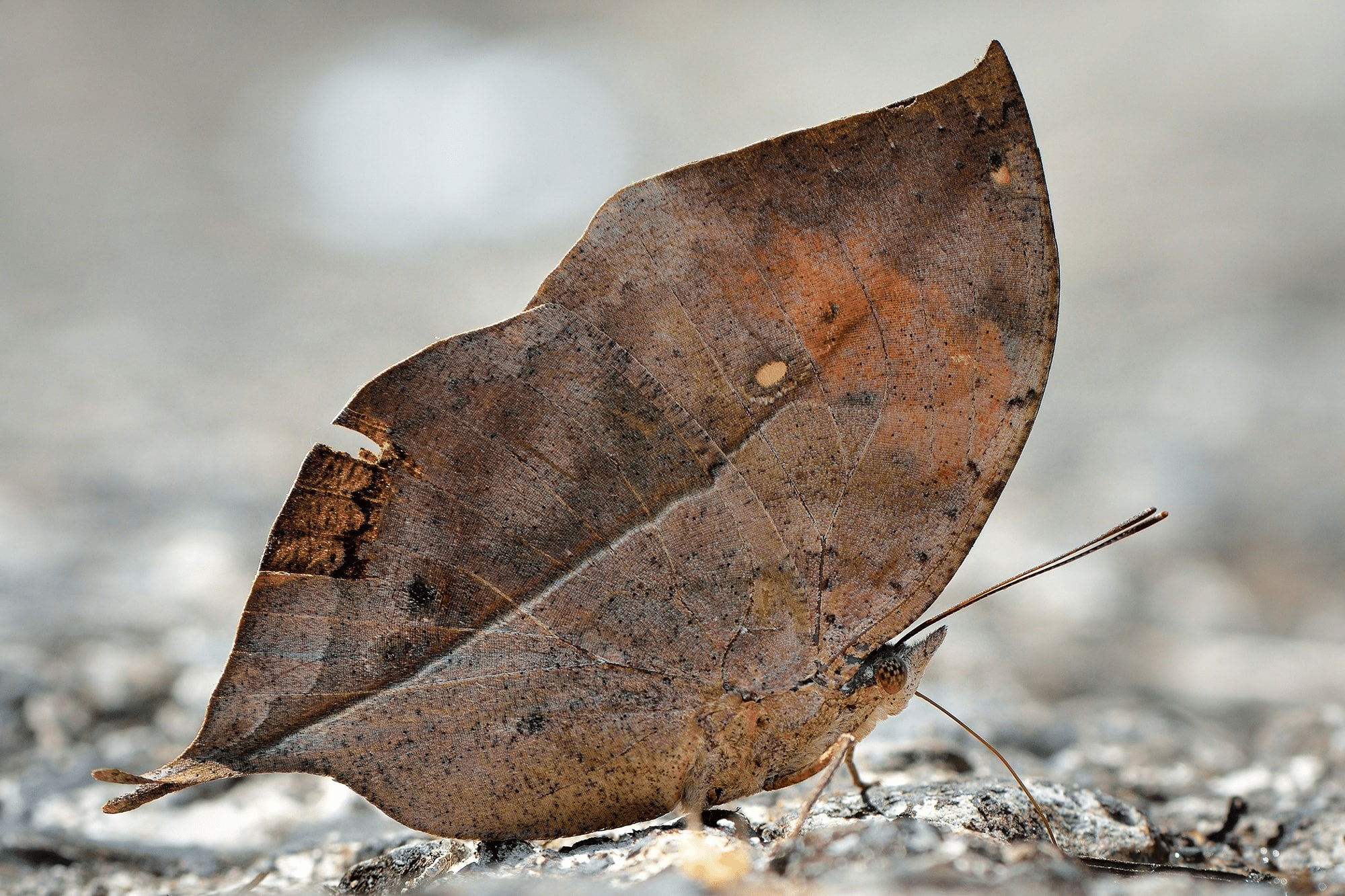
An incredible master of disguise, the Dead Leaf Butterfly blends into its surroundings by mimicking a dried leaf when its wings are closed.
It is a quiet forest dweller, mostly found in Asia. When disturbed, it reveals bright orange and blue patterns on the upper wings.
- Scientific Name: Kallima inachus
- Family: Nymphalidae
- Habitat: Tropical forests, dense foliage
- Physical Features: Leaf-shaped wings with jagged edges
- Colours in the Species: Brown (underside), orange and blue (upper side)
10. Emerald Swallowtail
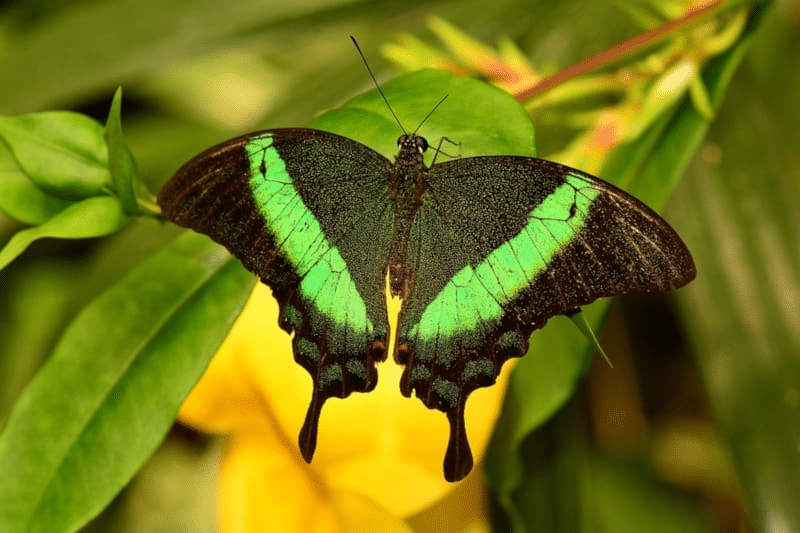
This breathtaking butterfly shimmers in iridescent green and black, appearing almost unreal.
Native to Southeast Asia, it thrives in warm, humid forests and has a strong, graceful flight.
Its metallic green band adds to its striking beauty.
- Scientific Name: Papilio palinurus
- Family: Papilionidae
- Habitat: Tropical forests, riverbanks
- Physical Features: Broad wings, iridescent green band
- Colours in the Species: Green, black, blue
11. Glasswing
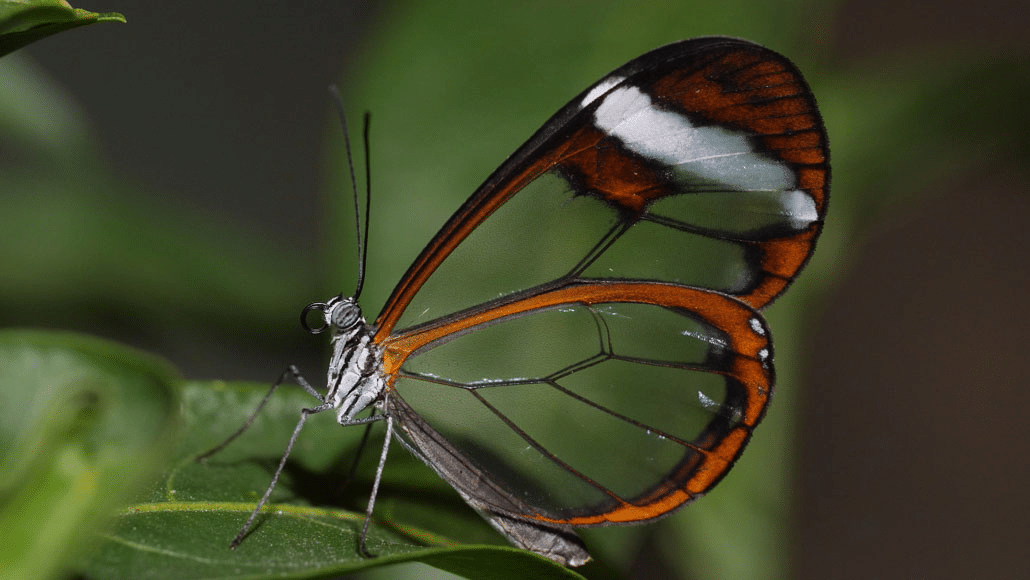
A delicate wonder of nature, the Glasswing butterfly has transparent wings that make it almost invisible among foliage.
Native to Central and South America, it relies on mimicry and chemical defenses to ward off predators.
- Scientific Name: Greta oto
- Family: Nymphalidae
- Habitat: Rainforests, cloud forests
- Physical Features: Transparent wings with dark brown borders
- Colours in the Species: Transparent, brown, orange
12. Glassy Tiger

A slow and graceful flyer, the Glassy Tiger butterfly has a delicate pattern of black veins over a blue and white background. Common in South and Southeast Asia, it often feeds on toxic plants, making it unpalatable to predators.
- Scientific Name: Parantica aglea
- Family: Nymphalidae
- Habitat: Mangroves, forests, gardens
- Physical Features: Slender body, long wings with vein-like markings
- Colours in the Species: Blue, black, white
13. Great Mormon
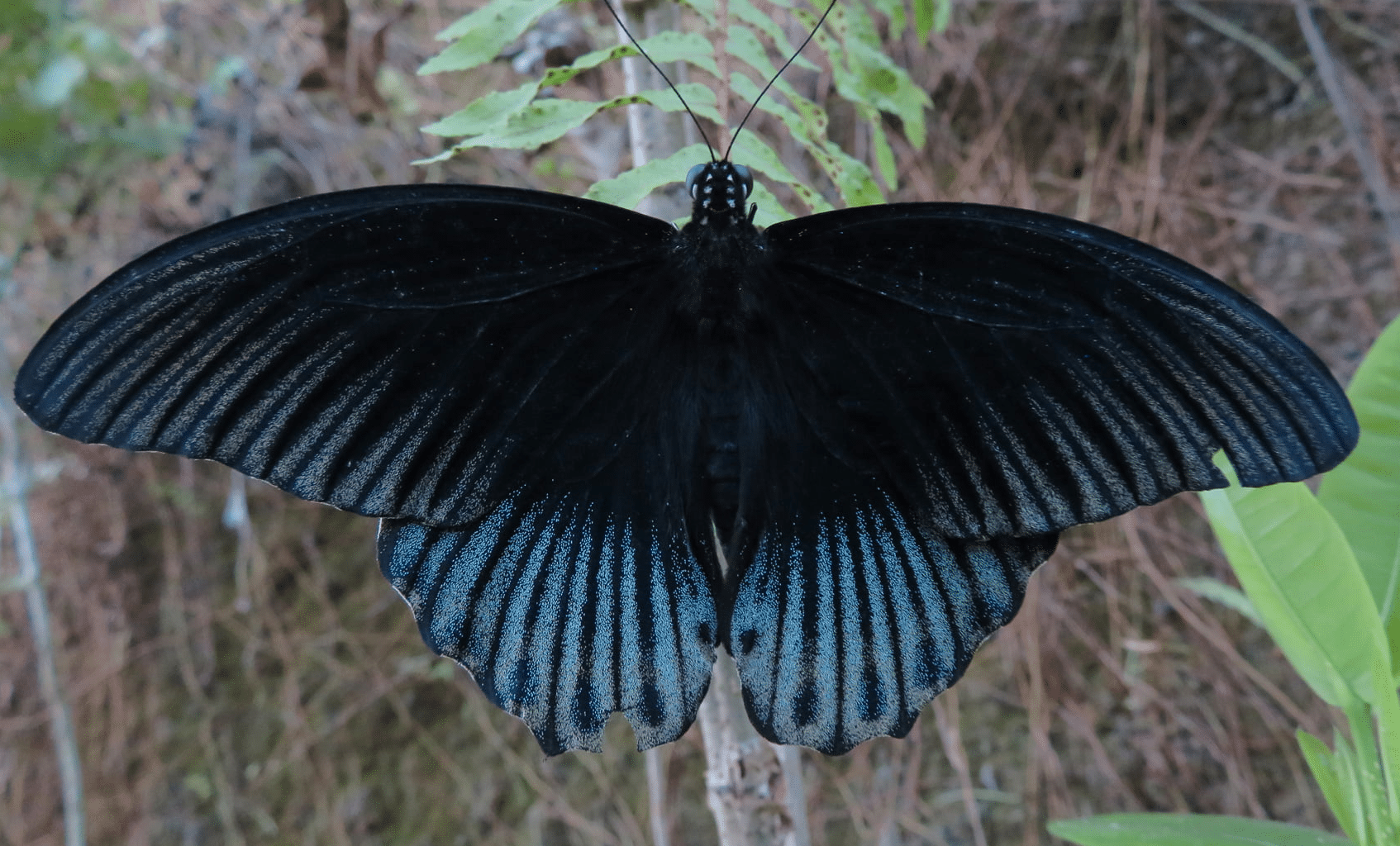
This large butterfly is a striking member of the swallowtail family, with males and females exhibiting different color patterns.
Native to Asia, the Great Mormon has a strong flight and often flits through forested areas and gardens.
- Scientific Name: Papilio memnon
- Family: Papilionidae
- Habitat: Tropical forests, gardens, rural areas
- Physical Features: Large wings, sexual dimorphism in coloration
- Colours in the Species: Black, blue, red, white
14. Green Dragontail
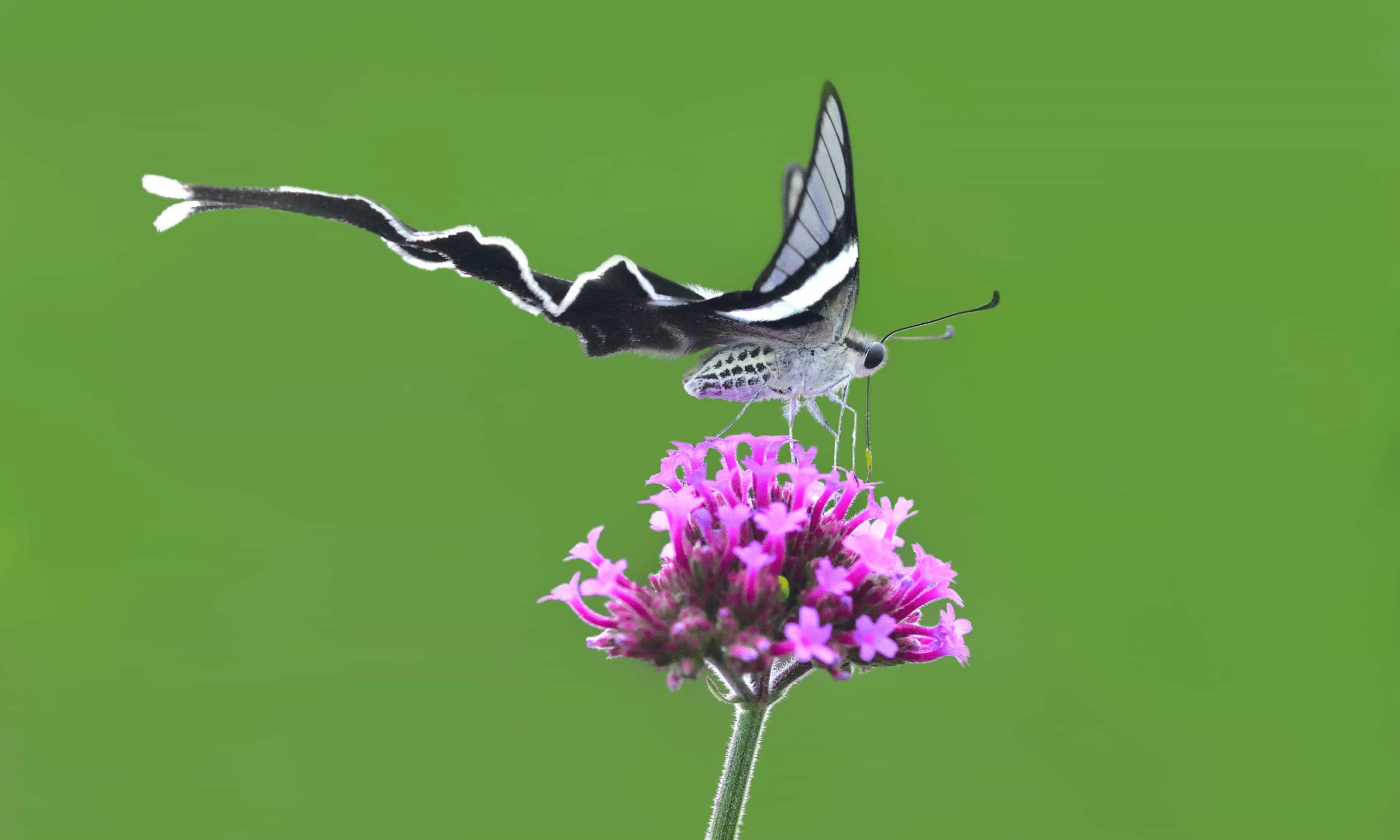
A truly unique butterfly, the Green Dragontail has long, narrow hindwing tails resembling a dragonfly’s tail.
It is a fast, low-flying species found near rivers and streams in Asia.
- Scientific Name: Lamproptera meges
- Family: Papilionidae
- Habitat: Forest streams, riverbanks
- Physical Features: Transparent wings with elongated tails
- Colours in the Species: Green, black, white
15. Julia Butterfly
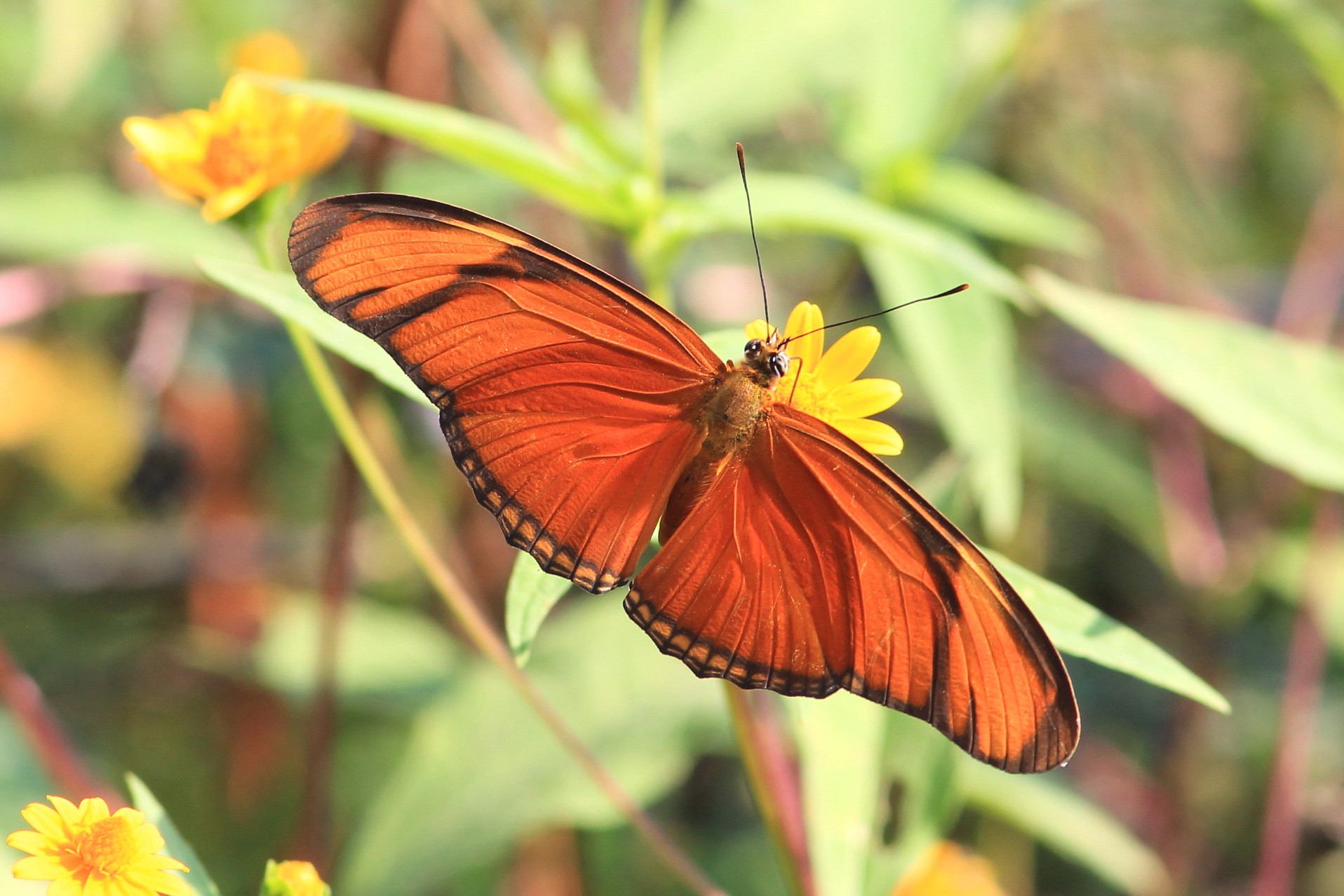
A bright orange beauty, the Julia Butterfly is a common sight in the Americas.
It is an active and energetic flyer, often basking in the sun with its wings spread wide.
- Scientific Name: Dryas iulia
- Family: Nymphalidae
- Habitat: Tropical and subtropical forests, gardens
- Physical Features: Slender body, elongated wings
- Colours in the Species: Orange, black
16. Kaiser-i-Hind
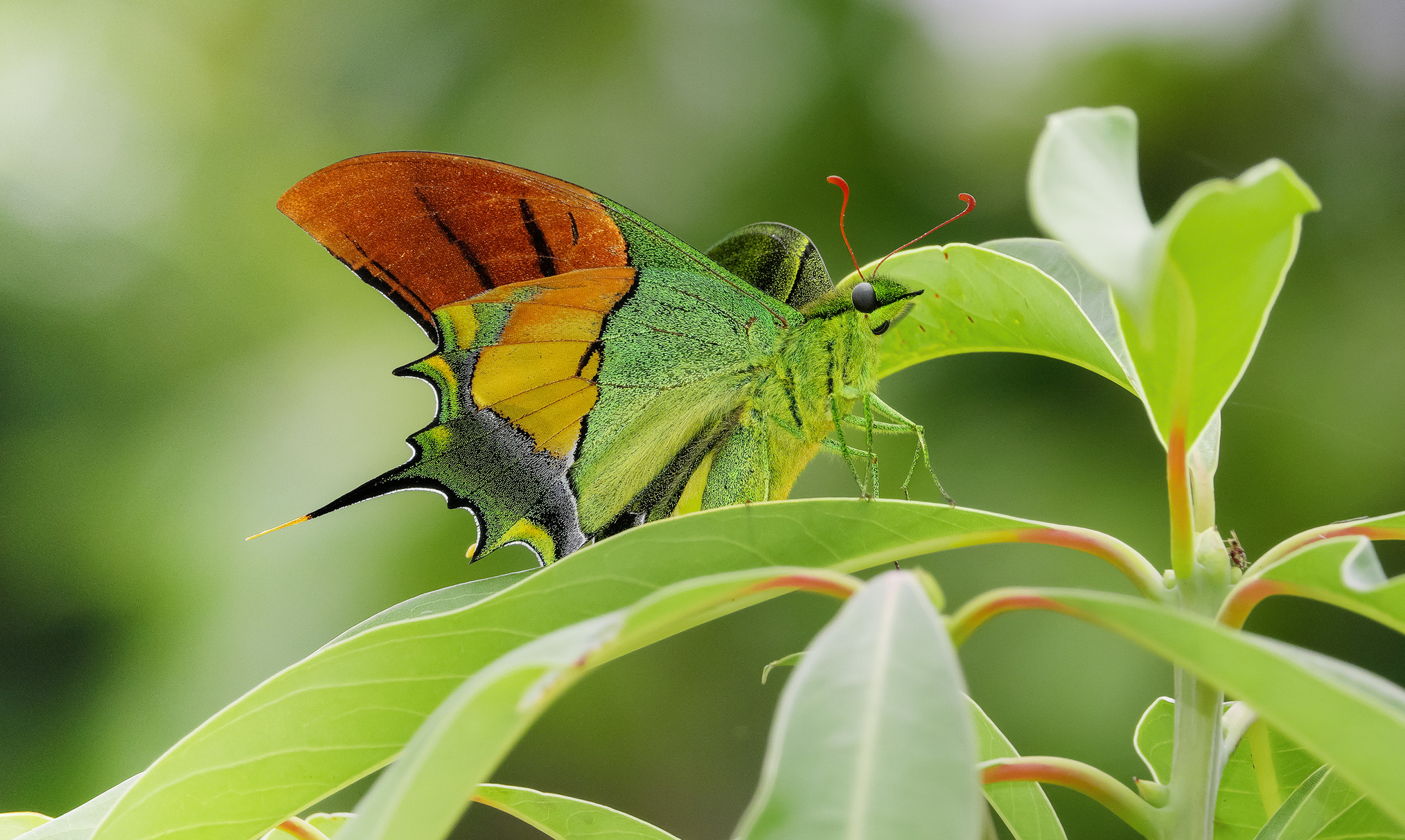
A rare and elusive butterfly, the Kaiser-i-Hind is highly prized for its shimmering green wings. Found in the forests of the Himalayas, it is a strong flier and difficult to spot in the wild.
- Scientific Name: Teinopalpus imperialis
- Family: Papilionidae
- Habitat: High-altitude forests
- Physical Features: Large wings with metallic green sheen
- Colours in the Species: Green, black, yellow
17. Malachite
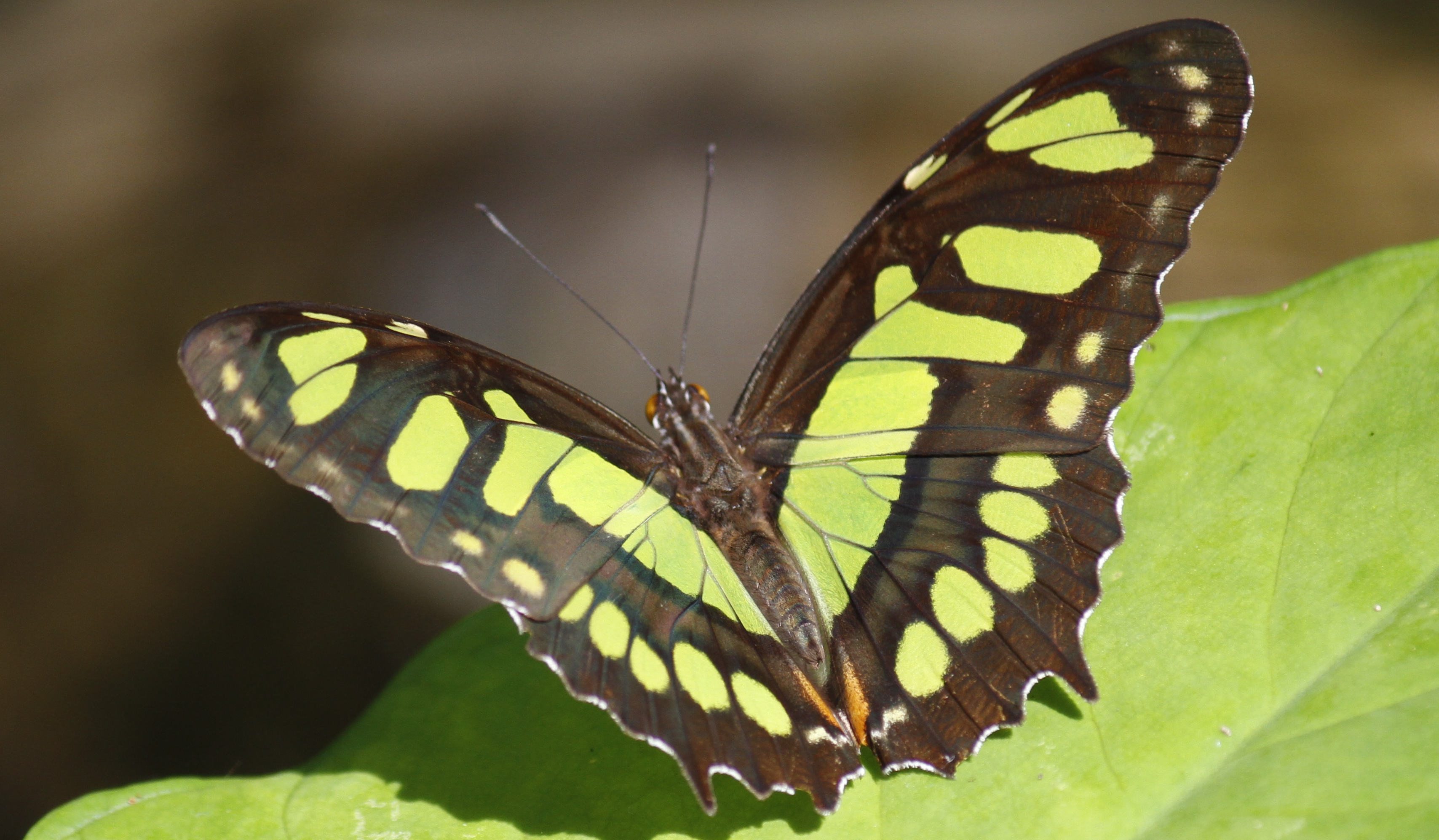
Named after the precious green mineral, the Malachite butterfly displays striking lime-green and black patterns.
It prefers warm climates and is often seen feeding on fruit rather than flowers.
- Scientific Name: Siproeta stelenes
- Family: Nymphalidae
- Habitat: Tropical forests, open fields
- Physical Features: Broad wings, vibrant green patches
- Colours in the Species: Green, black, brown
18. Monarch
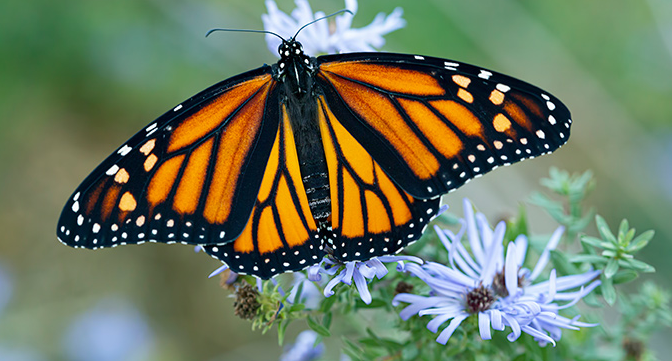
Perhaps the most famous butterfly, the Monarch is known for its epic migration across North America.
Its striking orange and black wings make it instantly recognizable, and it is toxic to predators due to the milkweed it consumes as a caterpillar.
- Scientific Name: Danaus plexippus
- Family: Nymphalidae
- Habitat: Meadows, gardens, coastal regions
- Physical Features: Sturdy wings, bold black veins
- Colours in the Species: Orange, black, white
19. Madagascan Moon Moth
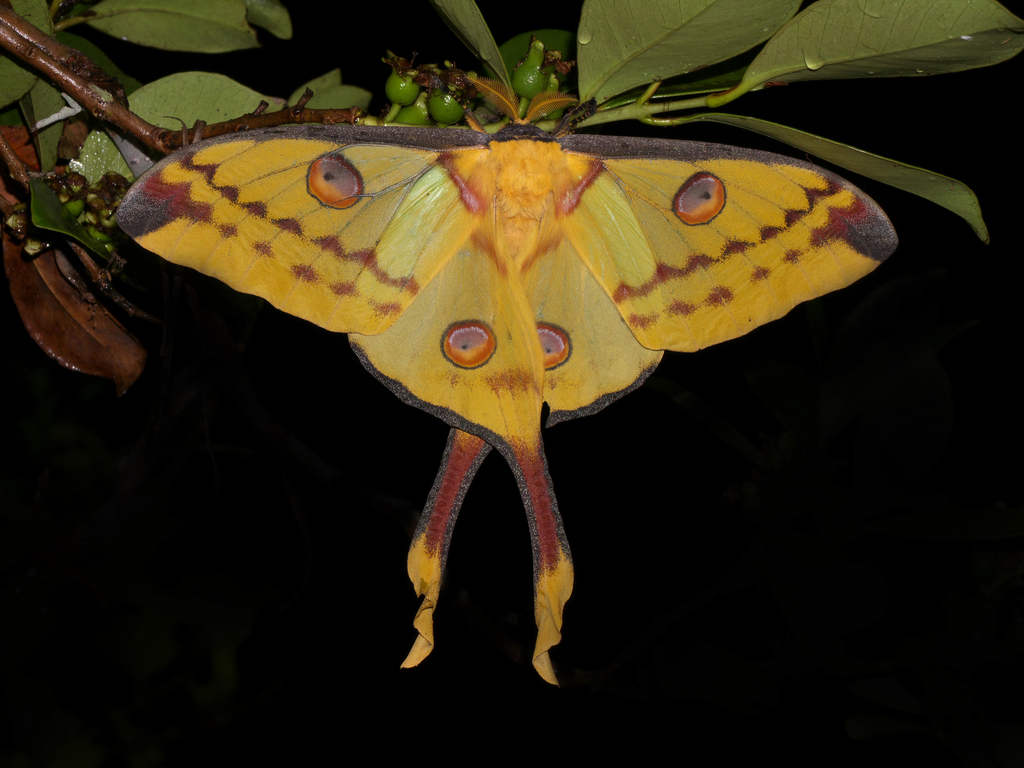
A breathtaking species, the Madagascan Moon Moth is one of the largest and most stunning silk moths in the world.
Its long tails and colourful yellow wings make it a striking sight in Madagascar’s rainforests.
Despite being a moth, its beauty rivals that of any butterfly.
- Scientific Name: Argema mittrei
- Family: Saturniidae
- Habitat: Tropical rainforests of Madagascar
- Physical Features: Large wings, elongated tails, eyespots
- Colours in the Species: Yellow, red, brown
20. Owl Butterfly
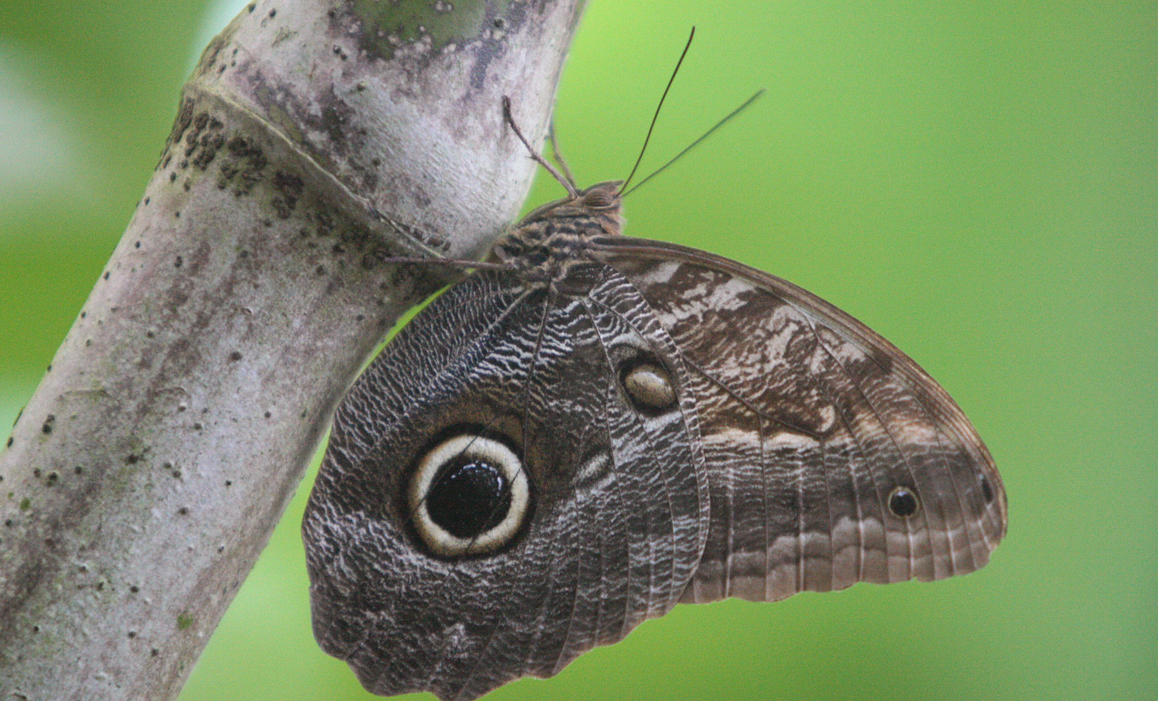
Famous for its enormous eye-like patterns, the Owl Butterfly is mostly active during dusk and dawn.
It prefers shaded forest understories, where its brown, camouflaged wings blend seamlessly into tree bark.
- Scientific Name: Caligo memnon
- Family: Nymphalidae
- Habitat: Rainforests, wooded areas
- Physical Features: Large wings with eye-like markings
- Colours in the Species: Brown, yellow, black
21. Painted Lady
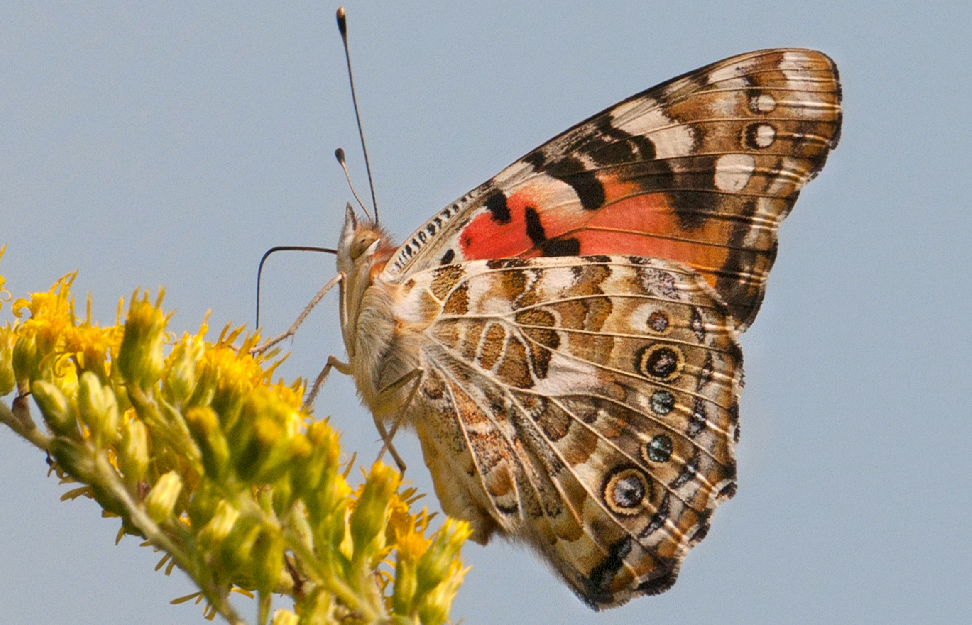
One of the most widespread butterflies, the Painted Lady is a strong migratory species seen across multiple continents.
It has a delicate mix of orange, black, and white patterns.
- Scientific Name: Vanessa cardui
- Family: Nymphalidae
- Habitat: Open fields, gardens, coastal regions
- Physical Features: Medium-sized, rounded wings
- Colours in the Species: Orange, black, white
22. Paper Kite
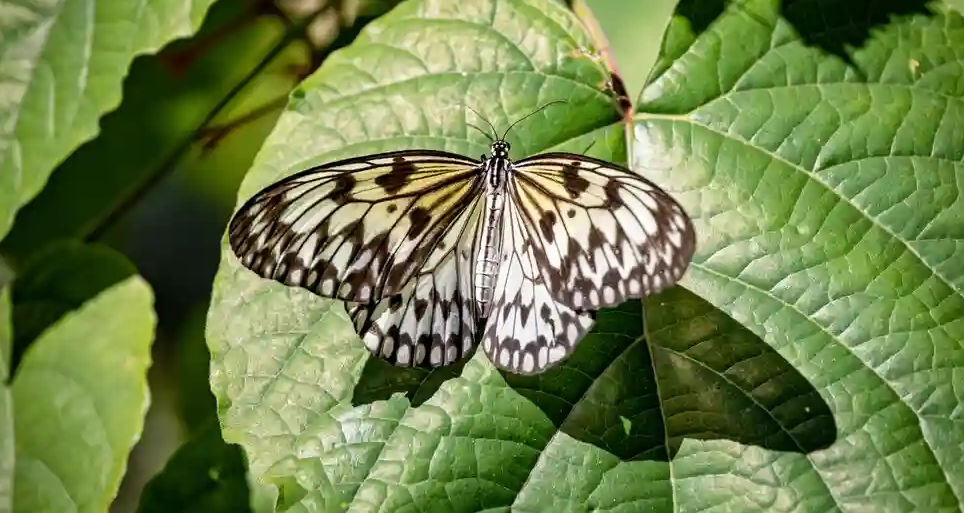
A slow and graceful flyer, the Paper Kite is known for its black-and-white patterned wings. Found in Southeast Asia, it has a floating flight pattern that makes it easy to recognize.
- Scientific Name: Idea leuconoe
- Family: Nymphalidae
- Habitat: Mangroves, coastal forests
- Physical Features: Thin body, broad translucent wings
- Colours in the Species: Black, white
23. Peacock Pansy
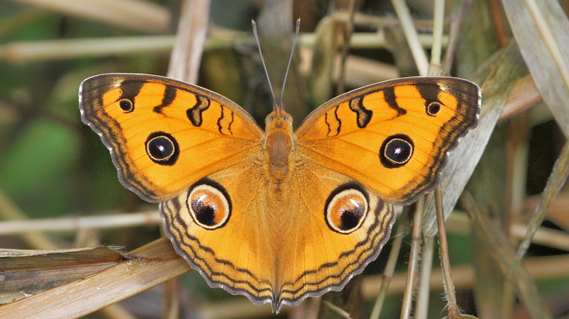
A small but striking butterfly, the Peacock Pansy has intricate eyespots that resemble a peacock’s feathers. Found in South and Southeast Asia, it is often seen basking in the sun.
- Scientific Name: Junonia almana
- Family: Nymphalidae
- Habitat: Grasslands, open fields, gardens
- Physical Features: Medium wingspan, bold eye spots
- Colours in the Species: Orange, brown, black
24. Postman Butterfly
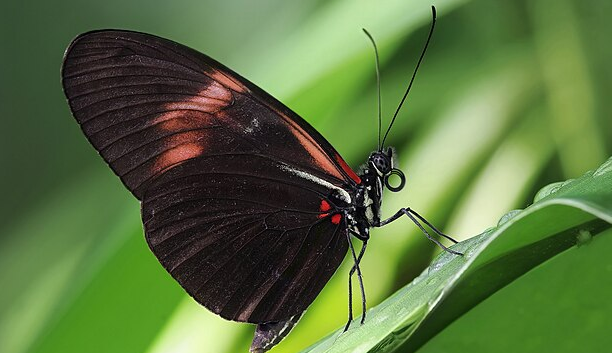
Recognized for its simple but graceful black wings with a single red or white stripe, the Postman Butterfly is common in tropical regions of Central and South America.
- Scientific Name: Heliconius melpomene
- Family: Nymphalidae
- Habitat: Rainforests, flower-rich gardens
- Physical Features: Slender body, elongated wings
- Colours in the Species: Black, red, white
25. Purple Emperor
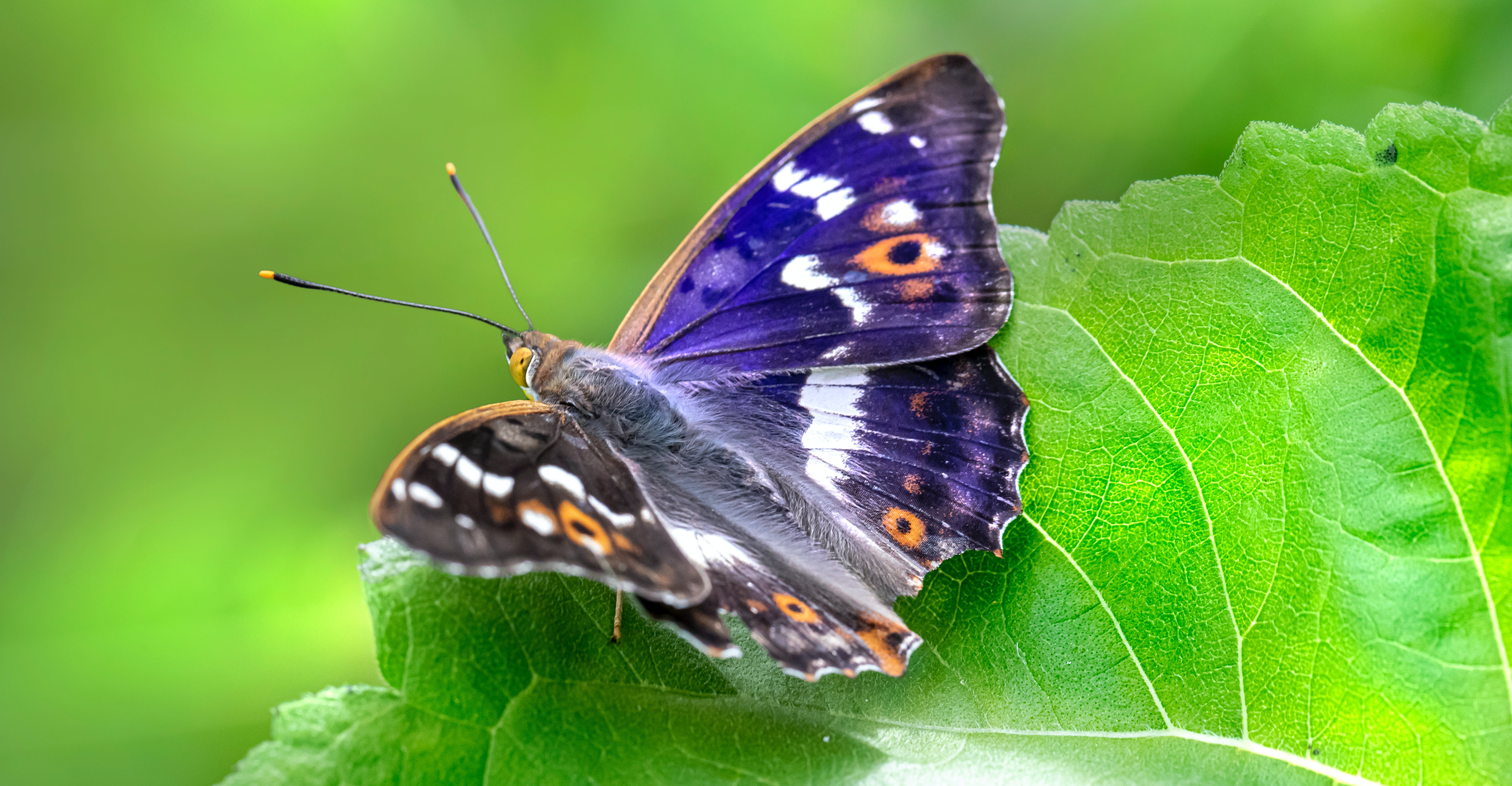
A regal butterfly with an iridescent purple sheen, the Purple Emperor is a majestic species found in European woodlands.
It spends most of its time high in tree canopies, descending only to feed on sap and carrion rather than flowers.
- Scientific Name: Apatura iris
- Family: Nymphalidae
- Habitat: Deciduous woodlands, riverbanks
- Physical Features: Large wings with a shimmering purple effect
- Colours in the Species: Purple, black, white
26. Rajah Brooke’s Birdwing
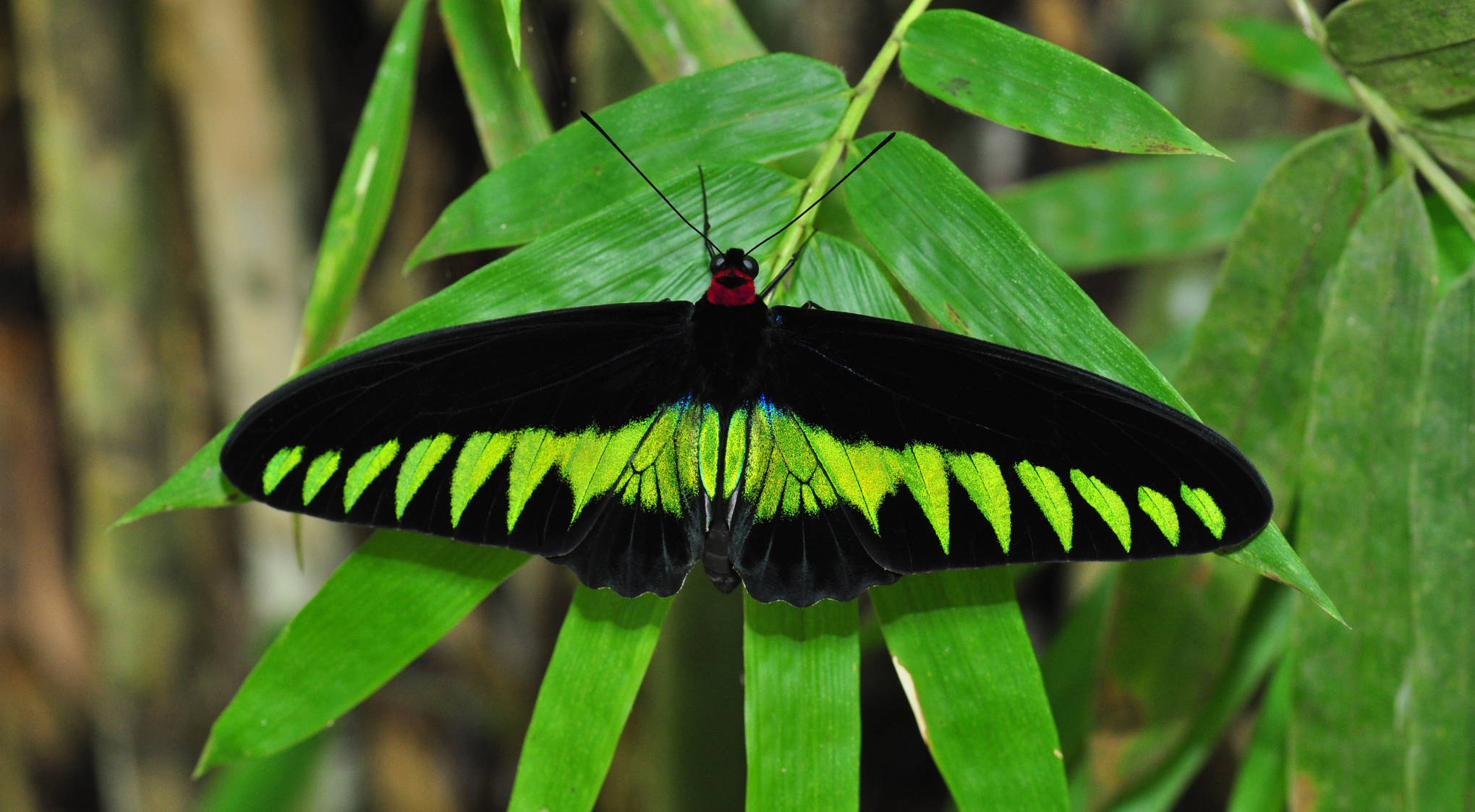
Malaysia’s national butterfly, this species is a vision of elegance with its long wings and vivid green markings. It is a protected species and thrives in pristine rainforest habitats.
- Scientific Name: Trogonoptera brookiana
- Family: Papilionidae
- Habitat: Rainforests, river valleys
- Physical Features: Long, narrow forewings, striking green bands
- Colours in the Species: Black, emerald green
27. Red Lacewing
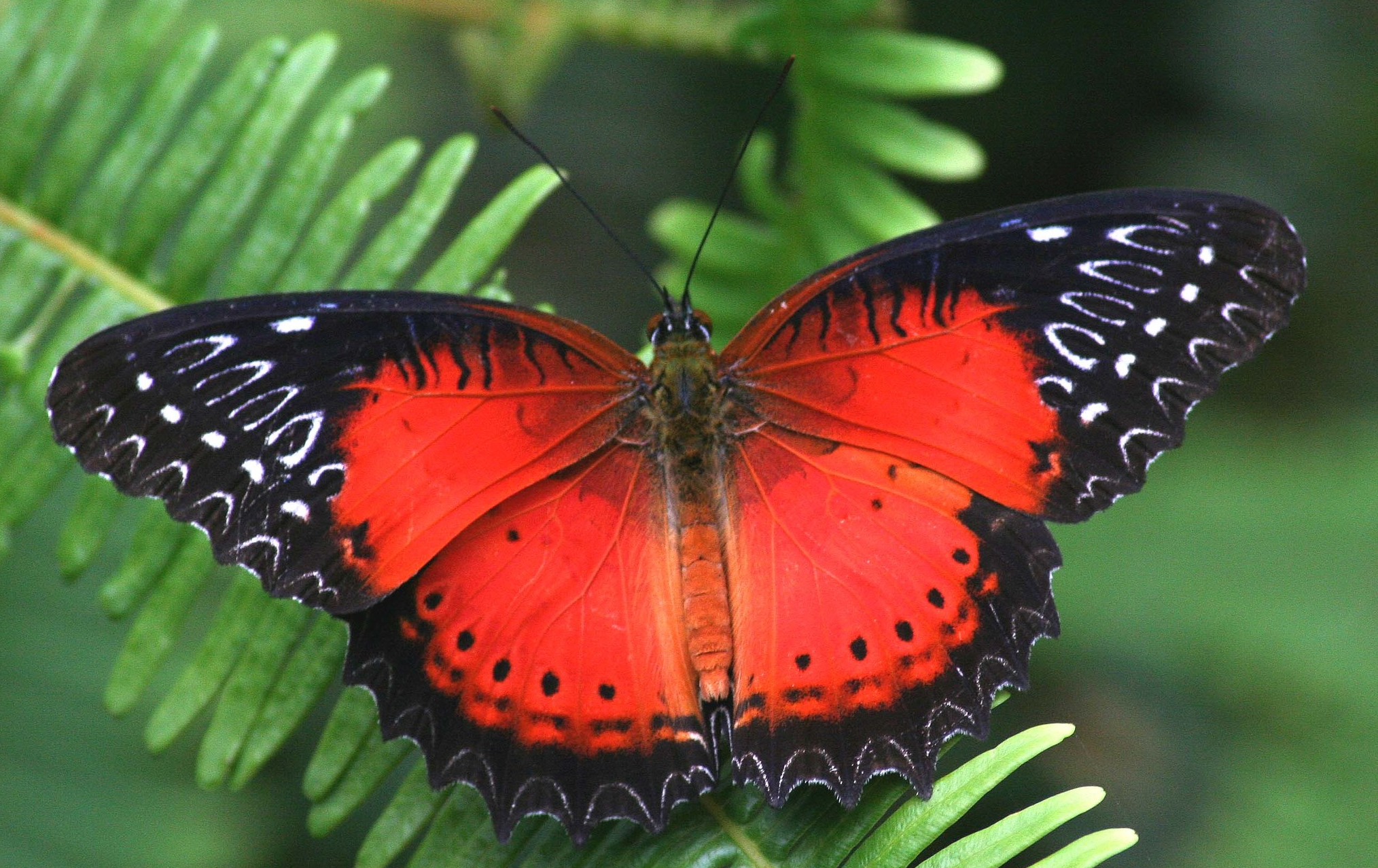
A vibrant butterfly with a rich red hue, the Red Lacewing is native to Southeast Asia and Australia. Its intricate black and white wing borders make it look like a delicate piece of lace.
- Scientific Name: Cethosia biblis
- Family: Nymphalidae
- Habitat: Tropical forests, gardens
- Physical Features: Broad, scalloped wings with lacy edges
- Colours in the Species: Red, black, white
28. Sapho Longwing
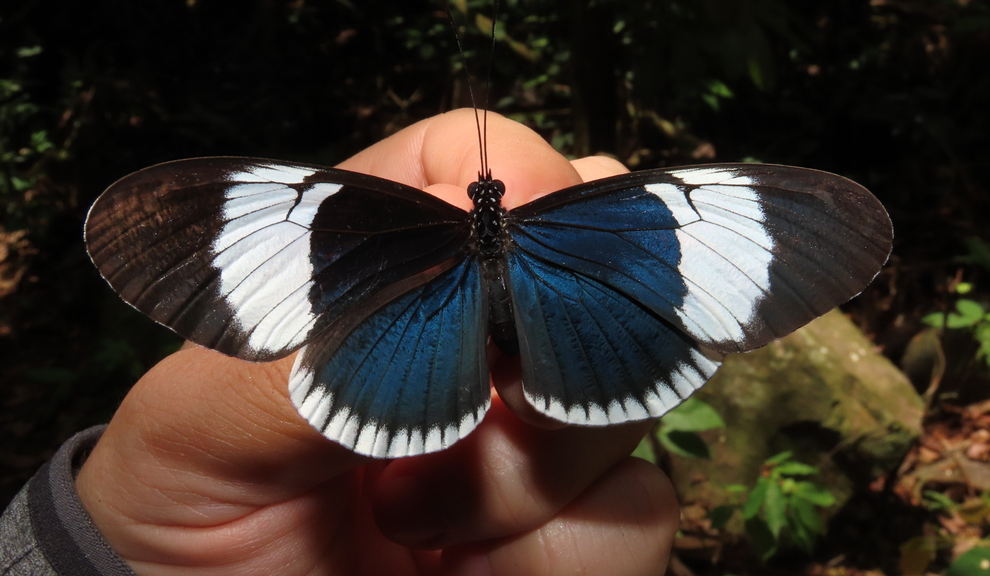
Known for its gentle, fluttering flight, the Sapho Longwing has a simple but graceful black-and-white wing pattern.
This species is native to Central America and prefers humid environments.
- Scientific Name: Heliconius sapho
- Family: Nymphalidae
- Habitat: Rainforests, shady trails
- Physical Features: Slender body, elongated wings
- Colours in the Species: Black, white, blue
29. Scarlet Peacock
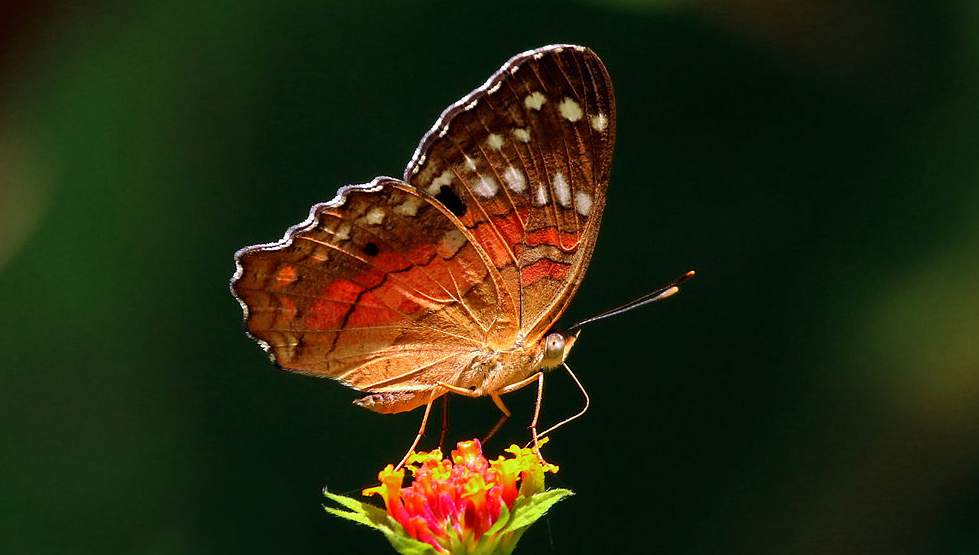
A small but fiery butterfly, the Scarlet Peacock is named for its deep red coloration and bold black patterns.
Found in South America, it is a common sight near rivers and open fields.
- Scientific Name: Anartia amathea
- Family: Nymphalidae
- Habitat: Wetlands, fields, tropical forests
- Physical Features: Rounded wings with eye-catching markings
- Colours in the Species: Red, black, white
30. Small Tortoiseshell
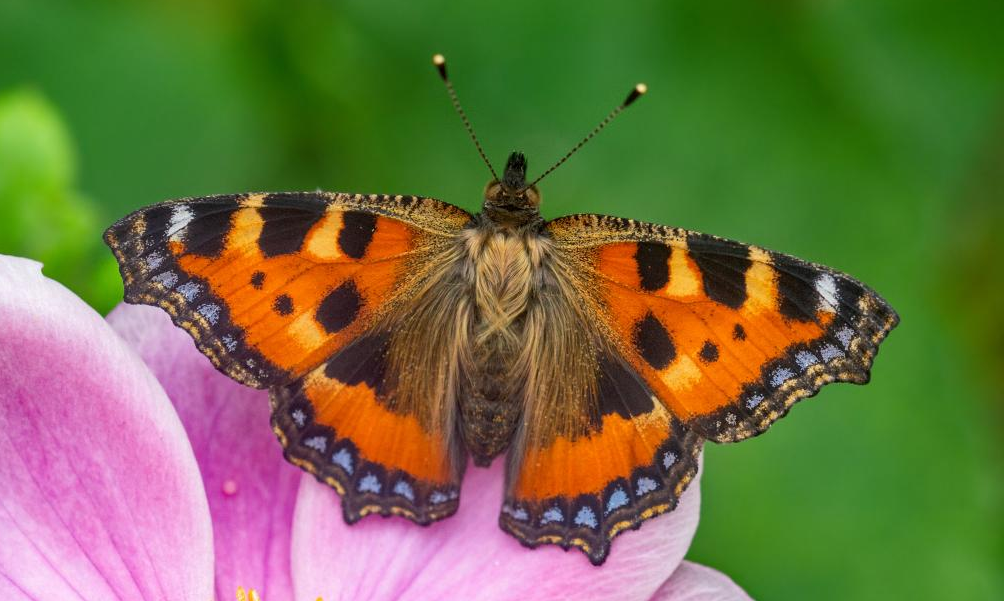
A hardy butterfly with a striking combination of orange, black, and blue, the Small Tortoiseshell is one of Europe’s most well-known butterflies.
It hibernates during winter and is often seen in early spring.
- Scientific Name: Aglais urticae
- Family: Nymphalidae
- Habitat: Meadows, gardens, woodland edges
- Physical Features: Medium-sized, scalloped wing edges
- Colours in the Species: Orange, black, blue
31. Sunset Moth
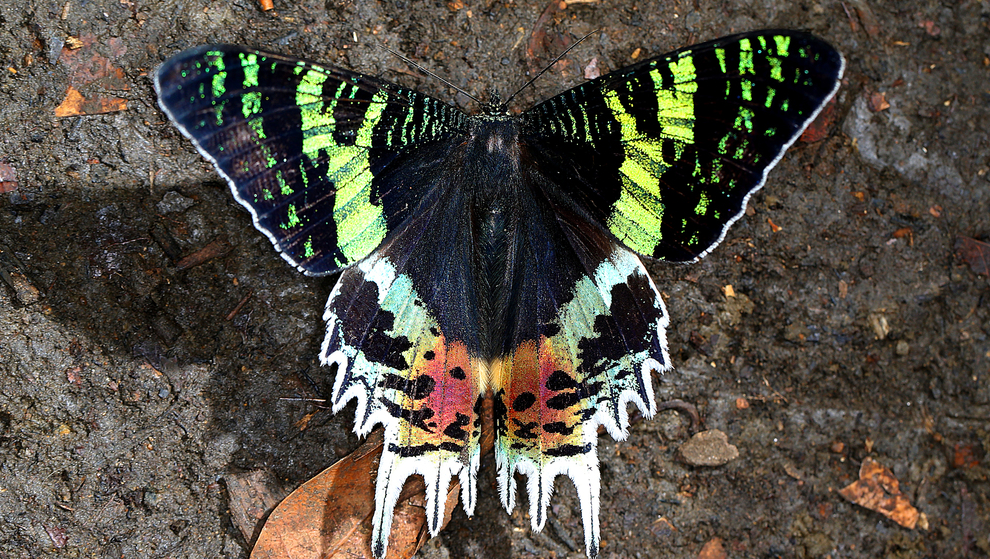
Unlike most moths, the Sunset Moth is active during the day and rivals butterflies in beauty.
Its iridescent green, red, and black hues make it one of the most spectacular insects in Madagascar.
- Scientific Name: Chrysiridia rhipheus
- Family: Uraniidae
- Habitat: Tropical forests, open fields
- Physical Features: Large, broad wings with metallic scales
- Colours in the Species: Green, red, black, blue
32. Tiger Swallowtail
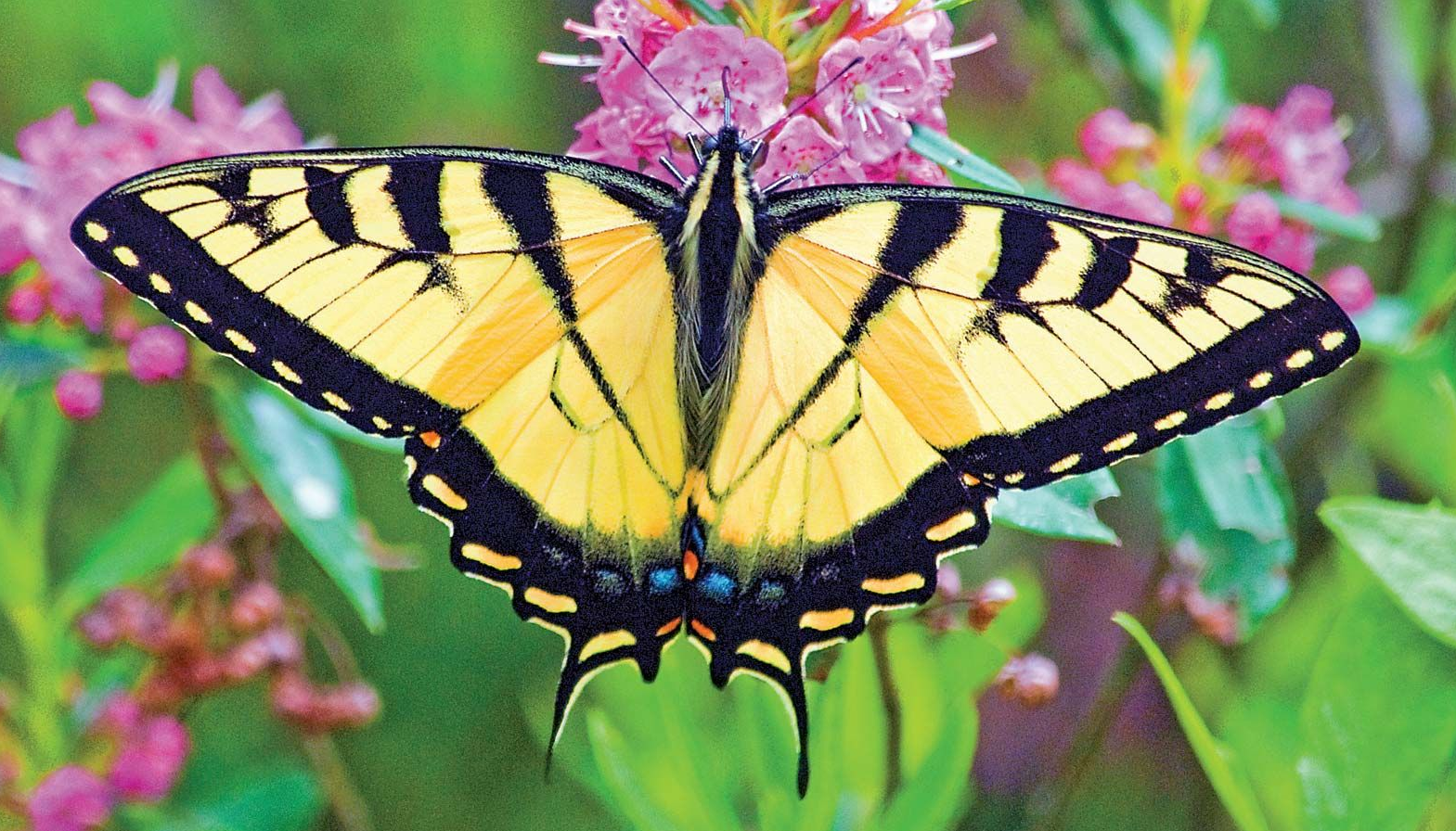
A large and graceful butterfly, the Tiger Swallowtail is famous for its yellow wings with black stripes.
Found in North America, it is a strong flier and can be seen near rivers and meadows.
- Scientific Name: Papilio glaucus
- Family: Papilionidae
- Habitat: Deciduous forests, gardens, wetlands
- Physical Features: Long tails, bold tiger-like patterns
- Colours in the Species: Yellow, black, blue
33. Ulysses Swallowtail
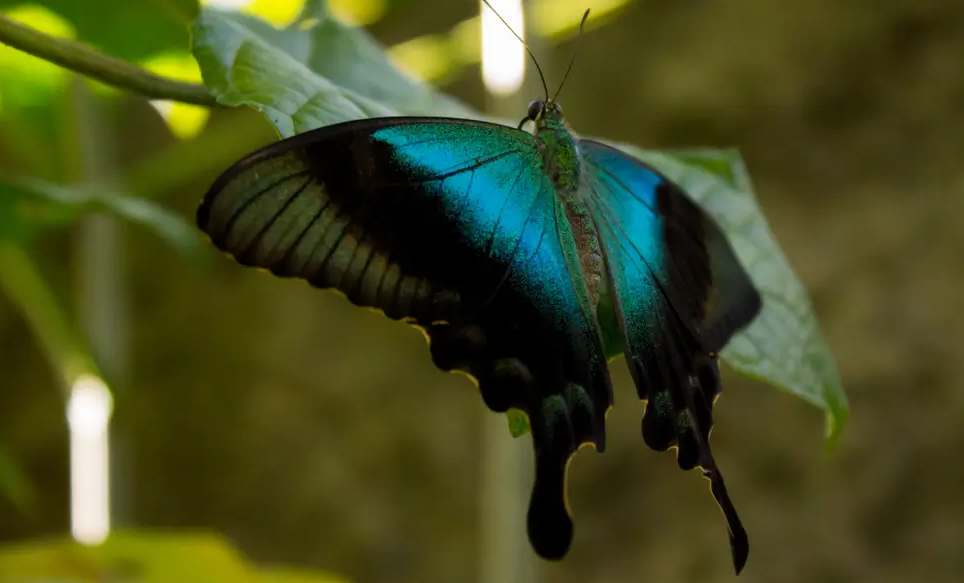
A dazzling electric blue butterfly, the Ulysses Swallowtail is a common sight in Australia and Papua New Guinea.
Its bright color contrasts with the dark rainforest, making it easily visible in flight.
- Scientific Name: Papilio ulysses
- Family: Papilionidae
- Habitat: Rainforests, coastal areas
- Physical Features: Large, broad wings with deep blue coloring
- Colours in the Species: Iridescent blue, black
34. White Admiral
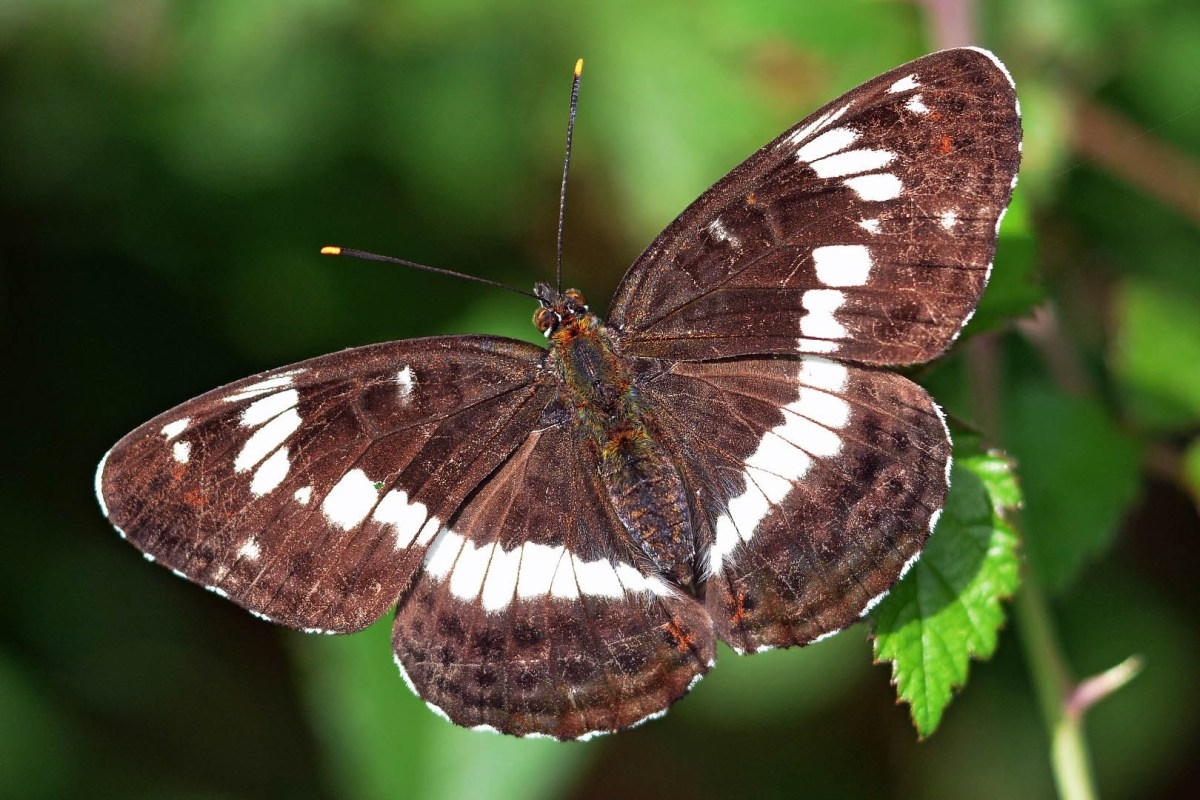
A magnificient butterfly with striking white bands on deep black wings, the White Admiral is found in both Europe and North America.
It glides gracefully through forested areas.
- Scientific Name: Limenitis camilla
- Family: Nymphalidae
- Habitat: Woodlands, shaded trails
- Physical Features: Medium-sized, graceful wing structure
- Colours in the Species: Black, white, blue
35. Zebra Longwing
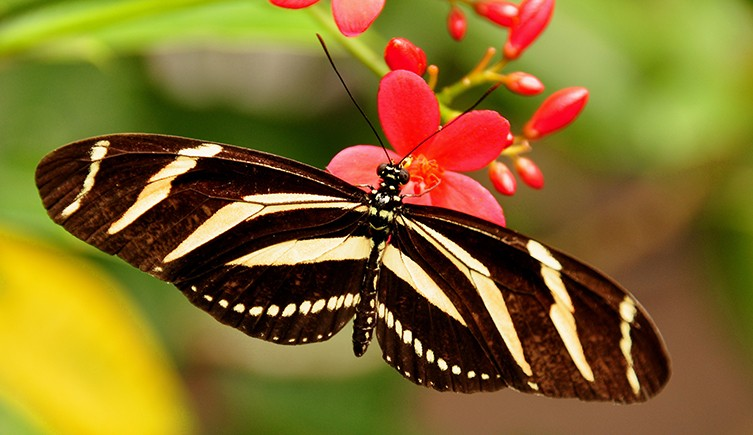
This butterfly gets its name from its zebra-like black and yellow stripes.
Found in the Americas, it has a slow, fluttering flight and is known to have a longer lifespan than most butterflies.
- Scientific Name: Heliconius charithonia
- Family: Nymphalidae
- Habitat: Tropical forests, gardens
- Physical Features: Long, narrow wings with distinct striping
- Colours in the Species: Black, yellow, white
How Can I Help Protect Beautiful Butterfly Species?
Butterfly populations face serious threats globally. Habitat loss remains their biggest challenge. Climate change disrupts their breeding cycles. Pesticides harm them directly. Urban development destroys their natural environments.
Anyone can make a difference in butterfly conservation. Small actions add up. Local efforts contribute to global impact. Community initiatives often show impressive results.
The following are some ways to protect butterflies around you:
- Plant native wildflowers in your garden to provide natural food sources for butterflies and their caterpillars.
- Create a “puddling station” with shallow dishes of water and sand where butterflies can gather minerals.
- Avoid using pesticides and herbicides that harm butterflies and their larvae.
- Leave fallen leaves in garden beds as many butterfly species overwinter in leaf litter.
- Support conservation organizations that work to protect butterfly habitats and migration corridors.
- Participate in citizen science projects that monitor butterfly populations in your area.
Final Word
Butterflies represent more than just colorful insects fluttering through gardens.
They serve as vital environmental indicators and essential pollinators. Their declining numbers signal a call to action for everyone.
Are you a butterfly enthusiast who loves to flutter puns around? Check out our butterfly puns to lighten up your day.
By creating butterfly-friendly spaces in our yards, avoiding harmful chemicals, and supporting conservation efforts, we can help these delicate creatures thrive. Even small actions make a difference in protecting butterfly habitats. The future of butterflies depends on our choices today.
Next time you spot a butterfly, take a moment to appreciate its beauty and purpose.What steps will you take for these natural messengers?
Share some tips in the comment section that can help other butterfly enthusiast participate to protect them.

